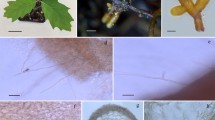Abstract
Progress was made towards a reliable in vitro system for mycorrhizing Cistus incanus seedlings with Tuber melanosporum. A rich growth medium favored extensive growth of mycorrhized Ri-transformed roots (MTR) but inhibited mycelial outgrowth into the medium. A minimal medium, on the other hand, inhibited MTR growth but supported considerable mycelial outgrowth into the medium. While the presence of a C.␣incanus propagule clearly enhanced mycelial growth into the minimal medium, a highly significant factor appeared to be the use of MTR inoculant, which supported mycorrhizal development to the Hartig net stage. The advantages of MTR for in vitro mycorrhization of host plant seedlings are discussed.
Similar content being viewed by others
Abbreviations
- DDW:
-
double distilled water
- MTR:
-
mycorrhized transformed roots
References
Balaji B, Poulin MJ, Vierheilig H, Piche Y, (1995) Responses of an arbuscular mycorrhizal fungus, Gigaspora margarita, to exudates and volatiles from the Ri T-DNA-transformed roots of nonmycorrhizal and mycorrhizal mutants of Pisum sativum. L Sparkle. Exp. Mycol. 19: 275–283
Becard G, Fortin JA, (1988) Early events of vesicular-arbuscular mycorrhiza formation on Ri T-DNA transformed rootsNew Phytol. 108:211–218
Berzin I, Mills D, Merchuk JC, (1999) A non-destructive method for secondary metabolite determination in hairy root culturesJ. Chem. Engineering of Japan 32: 229–234
Brown D (2001) Developing a truffle industry in Tasmania. In: Fédération française des trufficulteurs eds. Proceedings of the Vth International Congress, Science and Cultivation of Truffle. March 4–6, 1999 (p. 331)
Castringano A, Goovaerts P, Lulli L, Bragato G, (2000) A geostatistical approach to estimate probability of occurrence of Tuber melanosporum in relation to some soil propertiesGeoderma 98: 95–113
Chevalier G, Grente J, Pollacsek A, (1973) Obtention de mycorhizes de differents Tuber par synthese a partir de spores en conditions gnotoxeniques et a partir de cultures pures de mycelium en conditions axeniques et gnotoxeniquesAnn.Phytopathol. 5: 107–108
Díez J, Manjón JL, Ková GM, Celestino C, Toribio M, (2000) Mycorrhization of vitroplants raised from somatic embryos of cork oak (Quercus suber L.)Appl. Soil Ecology 15: 119–123
Dubé SL (2003) Vitro truffle mycorrhized hazels and oaks for␣the establishment of truffle orchards are unrestrained travelers. 3rd International Workshop on Edible Mycorrhizal Mushrooms, August 16–22, 2003, Victoria, BC, Canada (abstract)
Fasolo Bonfante P, Brunel A, (1972) Caryological features in a mycorrhizal fungus: Tuber melanosporum Vitt Allionia 18: 5–11
Garland F (2001) Growing Tuber melanosporum under adverse acid soil conditions in the United States of America. In: Fédération française des trufficulteurs eds. Proceedings of the Vth International Congress, Science and Cultivation of Truffle. March 4–6, 1999 (p. 393)
Gay G, Normand L, Marmeisse R, Sotta B, Deboud JC, (1994) Auxin overproducer mutants of Hebeloma cylindrosporum Romagnesi have increased mycorrhizal activityNew Phytol. 128: 645–657
Giovannetti G, Roth-Bejerano N, Zanini E & Kagan-Zur V, (eds) (1994) Truffles and their cultivation. Hortic. Rev. 16: 71–107
Hall IR, Brown G, Byars J, (1994) The black truffle: its history, uses and cultivation. Crop&Food Research, Lincoln, New Zealand, 107p
Hall IR, Yun W, Amicucci A, (2003) Cultivation of edible ectomycorrhizal mushroomsTrend Biotechnol. 21: 433–438
Hoagland DR, Arnon DI, (1950) The water culture method for plants without soil. Circular 374. University of California, Agriculture Experimental Station, Berkeley. pp28–31
Kagan-Zur V, Raveh E, Lischinsky S, Roth-Bejerano N, (1994) Initial association between Helianthemum and Terfezia is enhanced by low iron in the growth mediumNew Phytol. 127: 567–570
Kagan-Zur V, Freeman S, Luzzati Y, Roth-Bejerano N, Shabi E, (2001) Survival of introduced Tuber melanosporum at two sites in Israel as measured by occurrence of mycorrhizasPlant Soil 229: 159–166
Martin F, Duplessis S, Ditengou F, Lagrange H, Voiblet C, Lapeyrie F, (2001) Developmental cross talking in ectomycorrhizal symbiosis: signals and communication genesNew Phytol. 151: 145–154
Morte MA, Cano A, Honrubia M, Torres P, (1994) In vitro mycorrhization of micropropagated Helianthemum almeriense plantlets with Terfezia claveryi (desert truffle)Agricultural Science in Finland 3:309–314
Murashige T, Skoog FA, (1962) A revised medium for rapid growth and bioassays with tobacco tissue culturesPhysiol. Plant. 15: 473–497
Pierleoni R, Vallorani L, Sacconi C, Sisti D, Giomaro G, Stocchi V, (2001) Evaluation of the enzymes involved in primary nitrogen metabolism in Tilia platyphyllos-Tuber borchii ectomycorrhizaePlant Physiol. Biochem. 39: 1111–1114
Pinkas Y, Maimon M, Shabi E, Elisha S, Shmulewich Y, Freeman S, (2000) Inoculation, isolation and identification of Tuber melanosporum from old and new oak hosts in IsraelMycol. Res. 104: 472–477
Roth-Bejerano N, Livne D, Kagan-Zur V, (1990) Helianthemum-Terfezia relations in different growth mediaNew Phytol. 114: 235–238
Shimon-Kerner N, Mills D, Merchuk JC, (2000) Sugar utilization and invertase activity in hairy-root and cell-suspension cultures of Symphytum officinalePlant Cell, Tiss. Org. Cult. 62: 89–94
Smith SE, Read DJ, (1997) Mycorrhizal symbiosis, Ed. 2 Academic Press, San Diego, London, New York, Boston, Sydney, Tokyo, Toronto pp.276–289
Thompson BD, Malajczuk N, Grove TS, Hardy GEStJ, (1993) Improving the colonization capacity and effectiveness of ectomycorrhizal fungal cultures by association with a host plant and re-isolationMycol. Res. 97: 839–844
Ventura Y, Bustan A, Kagan-Zur V, Roth-Bejerano N & Mills D (2003) Effect of sugars on in vitro growth of Cistus incanus transformed roots and of Tuber melanosporum mycelium. ICOM4, Montreal, Canada (abstract)
Verlhac A, Giraud M, Leteinturier J, (1990) La truffe - Guide pratique. CTFL, Paris
Wenkart S, Roth-Bejerano N, Mills D, Kagan-Zur V, (2001) Mycorrhizal association between Tuber melanosporum mycelia and transformed roots of Cistus incanusPlant Cell Rep. 20: 369–373
Author information
Authors and Affiliations
Corresponding author
Rights and permissions
About this article
Cite this article
Ventura, Y., Mills, D., Kagan-Zur, V. et al. Mycorrhized Ri-transformed roots facilitate in vitro inoculation of Cistus incanus with Tuber melanosporum . Plant Cell Tiss Organ Cult 85, 53–61 (2006). https://doi.org/10.1007/s11240-005-9048-0
Received:
Accepted:
Published:
Issue Date:
DOI: https://doi.org/10.1007/s11240-005-9048-0




